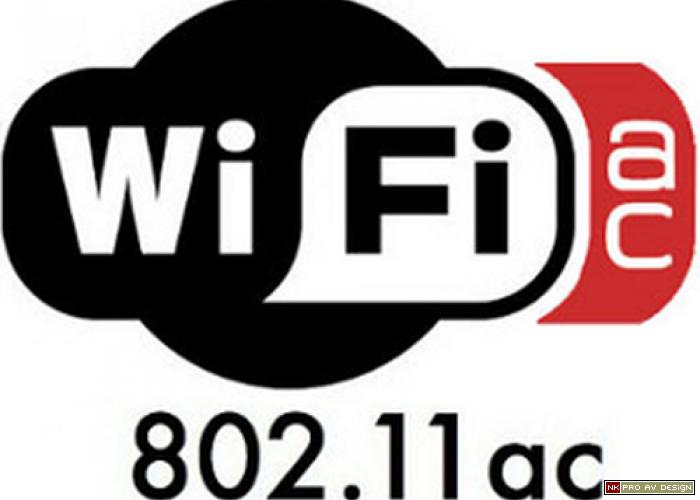How 802.11ac works
Years ago, 802.11n introduced some exciting technologies that brought massive speed boosts over 802.11b and g. 802.11ac does something similar compared with 802.11n. For example, whereas 802.11n had support for four spatial streams (4×4 MIMO) and a channel width of 40MHz, 802.11ac can utilize eight spatial streams and has channels up to 80MHz wide — which can then be combined to make 160MHz channels. Even if everything else remained the same (and it doesn’t), this means 802.11ac has 8x160MHz of spectral bandwidth to play with, vs. 4x40MHz — a huge difference that allows it to squeeze vast amounts of data across the airwaves.
To boost throughput further, 802.11ac also introduces 256-QAM modulation (up from 64-QAM in 802.11n), which basically squeezes 256 different signals over the same frequency by shifting and twisting each into a slightly different phase. In theory, that quadruples the spectral efficiency of 802.11ac over 802.11n. Spectral efficiency is a measure of how well a given wireless protocol or multiplexing technique uses the bandwidth available to it. In the 5GHz band, where channels are fairly wide (20MHz+), spectral efficiency isn’t so important. In cellular bands, though, channels are often only 5MHz wide, which makes spectral efficiency very important.
802.11ac also introduces standardized beamforming (802.11n had it, but it wasn’t standardized, which made interoperability an issue). Beamforming is essentially transmitting radio signals in such a way that they’re directed at a specific device. This can increase overall throughput and make it more consistent, as well as reduce power consumption. Beamforming can be done with smart antennae that physically move to track the device, or by modulating the amplitude and phase of the signals so that they destructively interfere with each other, leaving just a narrow, not-interfered-with beam. 802.11n uses this second method, which can be implemented by both routers and mobile devices. Finally, 802.11ac, like 802.11 versions before it, is fully backwards compatible with 802.11n and 802.11g — so you can buy an 802.11ac router today, and it should work just fine with your older WiFi devices.
The range of 802.11ac
In theory, on the 5GHz band and using beamforming, 802.11ac should have the same or better range than 802.11n (without beamforming). The 5GHz band, thanks to less penetration power, doesn’t have quite the same range as 2.4GHz (802.11b/g). But that’s the trade-off we have to make: There simply isn’t enough spectral bandwidth in the massively overused 2.4GHz band to allow for 802.11ac’s gigabit-level speeds. As long as your router is well-positioned, or you have multiple routers, it shouldn’t matter a huge amount. As always, the more important factor will likely be the transmission power of your devices, and the quality of their antennas.
How fast is 802.11ac?
And finally, the question everyone wants to know: Just how fast is WiFi 802.11ac? As always, there are two answers: the theoretical max speed that can be achieved in the lab, and the practical maximum speed that you’ll most likely receive at home in the real world, surrounded by lots of signal-attenuating obstacles.
The theoretical max speed of 802.11ac is eight 160MHz 256-QAM channels, each of which are capable of 866.7Mbps — a grand total of 6,933Mbps, or just shy of 7Gbps. That’s a transfer rate of 900 megabytes per second — more than you can squeeze down a SATA 3 link. In the real world, thanks to channel contention, you probably won’t get more than two or three 160MHz channels, so the max speed comes down to somewhere between 1.7Gbps and 2.5Gbps. Compare this with 802.11n’s max theoretical speed, which is 600Mbps.
The future of 802.11ac
802.11ac will only get faster, too. As we mentioned earlier, the theoretical max speed of 802.11ac is just shy of 7Gbps — and while you’ll never hit that in a real-world scenario, we wouldn’t be surprised to see link speeds of 2Gbps or more in the next few years. At 2Gbps, you’ll get a transfer rate of 256MB/sec, and suddenly Ethernet serves less and less purpose if that happens. To reach such speeds, though, chipset and device makers will have to suss out how to implement four or more 802.11ac streams, both in terms of software and hardware.
We imagine Broadcom, Qualcomm, MediaTek, Marvell, and Intel are already well on their way to implementing four- and eight-stream 802.11ac solutions for integration in the latest routers, access points, and mobile devices — but until the 802.11ac spec is finalized, second-wave chipsets and devices are unlikely to emerge. A lot of work will be have to done by the chipset and device makers to ensure that advanced features, such as beamforming, comply with the standard and are interoperable with other 802.11ac devices.
article by sebastien A. updated with new information by Najib K.

